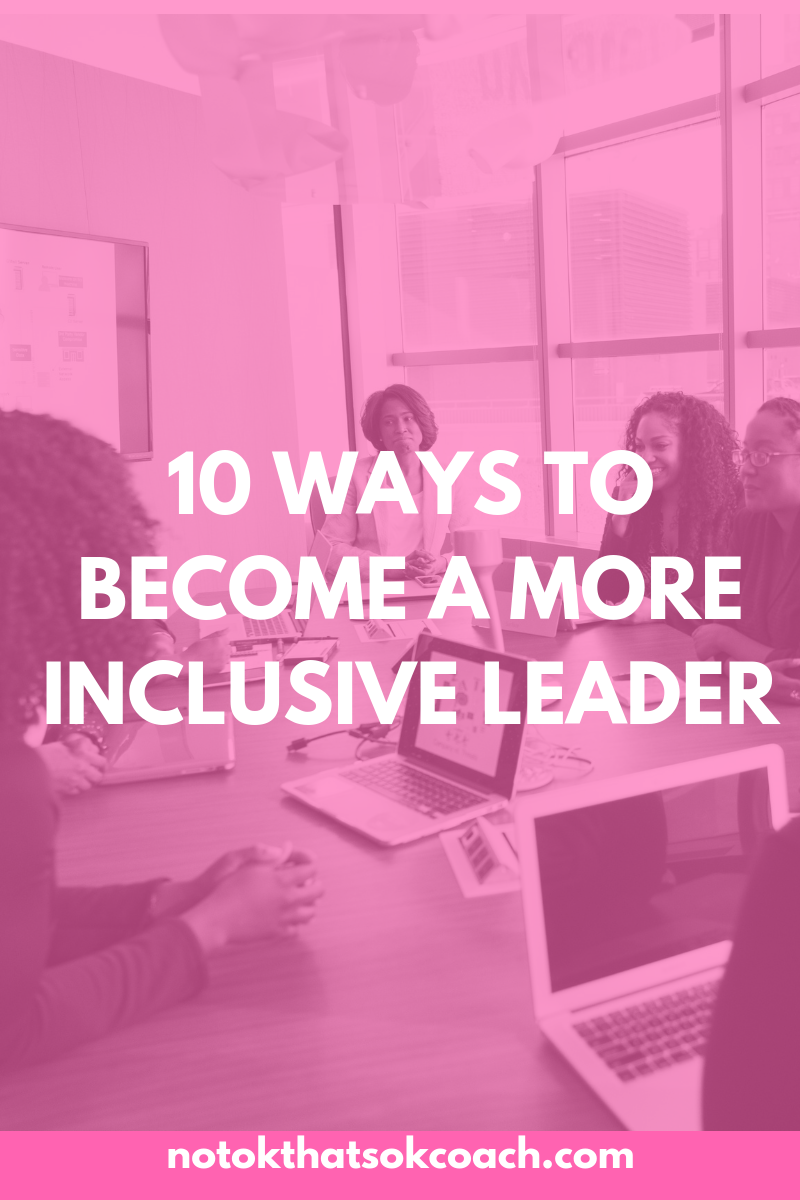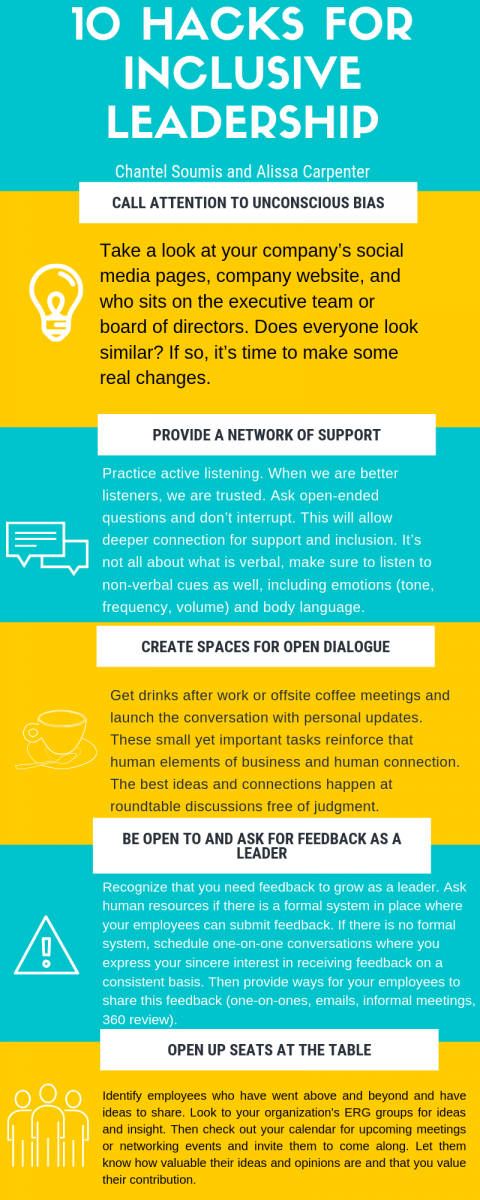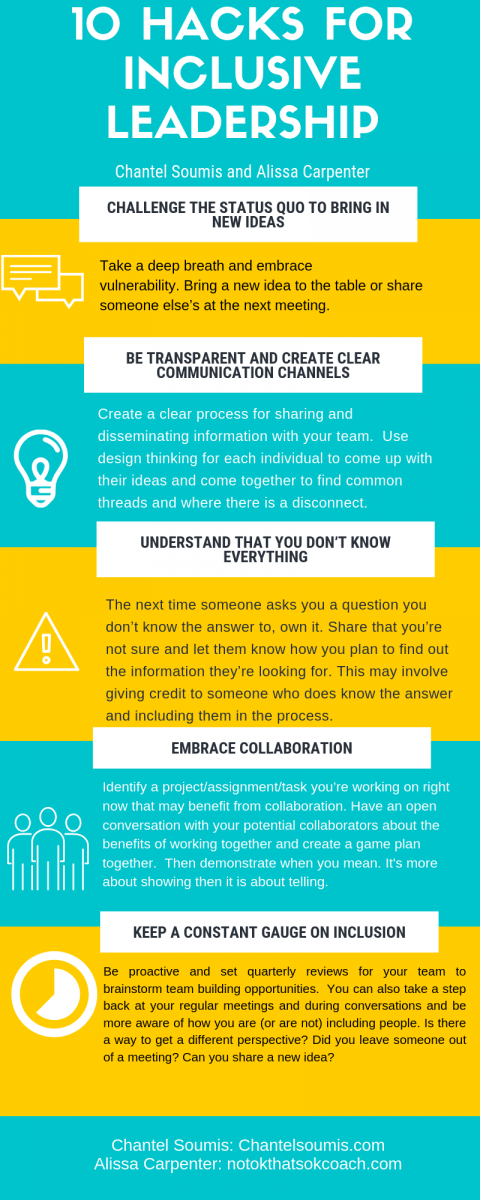By: Chantel Soumis and Alissa Carpenter
It’s no secret that we need to focus on creating more inclusive environments for our diverse workforces. Feeling valued and heard is one of the key indicators of whether or not an employee is engaged. With that said, it takes time and a concentrated effort by leadership to create real change. There is no easy solution but there are ways to start making it a part of company culture. Let’s go through 10 hacks to be a more inclusive leader.
Call attention to unconscious bias
“Think of driving your car down the highway. You want to shift into the right lane, so you click your turn signal and look in your rear and side view mirrors. It’s all clear; you start to make your way over to the next lane. A car horn blasts and you swerve back into your lane, realizing you just missed crashing into a car that was in that right lane — one you didn’t see because it was in your car’s blind spot. Just like a car, we don’t see what’s in another lane. Unconscious bias is a blind spot that can cause damage because you don’t know it’s there.” – Susan Taylor, CEO of Generon International
Whether we’re aware of it or not, bias seeps into the hiring and promotion process. We unconsciously favor people who think, look, and experience life similar to us versus people who don’t. It is much easier to relate to these individuals and see where they would “fit” in the organization.
Unfortunately, by doing so we’re missing out on the the opportunity for more innovative ideas, unique skills, and to grow our talent pools. To hire more diverse people, we need to take a step back and look at the diversity within the organization. People need to be able to see that we’re making a conscious effort to promote based on talent and actually see a future for themselves.
Action steps: Take a look at your company’s social media pages, company website, and who sits on the executive team or board of directors. Does everyone look similar? If so, it’s time to make some real changes.
Provide a network of support
Community is paramount in building supportive, inclusive environments. Although we are more digitally connected than ever before, loneliness is at an all time high with Generation Z deemed “the loneliest generation yet.” This is a problem for many reasons, including the highest suicide rates in history and rise of chronic illness where stress plays a major role.
Creating a warm environment where people feel more connected and able to share struggles for support is of utmost importance for diversity and inclusion efforts.
Action steps: Practice active listening. When we are better listeners, we are trusted. Ask open-ended questions and don’t interrupt. This will allow deeper connection for support and inclusion. It’s not all about what is verbal, make sure to listen to non-verbal cues as well, including emotions (tone, frequency, volume) and body language.
Create spaces for open dialogue
It’s one thing to say you’re an inclusive leader and another to actually be one. Creating spaces for open dialogue and small talk means conversation on both sides. Sharing information about yourself and listening to employees when they share. We can’t expect others to provide personal information, if we’re not being vulnerable ourselves.
This may involve weekly one-on-ones or informal gatherings. It’s an opportunity to lighten the mood of stress and overwhelm where team members can voice opinions and challenges to find support.
Action steps: Get drinks after work or offsite coffee meetings and launch the conversation with personal updates. These small yet important tasks reinforce that human elements of business and human connection. The best ideas and connections happen at roundtable discussions free of judgment.
Be open to and ask for feedback as a leader
Feedback is the greatest resource for growth. Particularly candid feedback where folks don’t feel pressured to provide only positive remarks. In order to grow as a leader and ensure constructive collaborations, feedback should be a foundation to your inclusion strategy.
Action steps: Recognize that you need feedback to grow as a leader. Ask human resources if there is a formal system in place where your employees can submit feedback. If there is no formal system, schedule one-on-one conversations where you express your sincere interest in receiving feedback on a consistent basis. Then provide ways for your employees to share this feedback (one-on-ones, emails, informal meetings, 360 review).
Open up seats at the table
Take a look around. Does everyone think and act like you? Do you all prefer coffee over tea? Cookies over cake? Do you all wear the same colors to work? It’s funny to analyze the similarities with people who have worked together over the years as they become more and more alike. Performing a room analysis on the community and determining who you could ask that could provide a fresh perspective could allow serious insight. Mix it up a bit and change your routine to include new thoughts and perspectives.
Action steps: Identify employees who have went above and beyond and have ideas to share. Look to your organization’s ERG groups for ideas and insight. Then check out your calendar for upcoming meetings or networking events and invite them to come along. Let them know how valuable their ideas and opinions are and that you value their contribution.
Challenge the status quo to bring in new ideas
Vulnerability brings BIG business. Without practicing vulnerability and connecting on a level deeper than the surface, we block ourselves off from friendships and growth opportunities. And if we don’t share our ideas and the ideas of others (while giving credit), our organizations won’t grow. We’ll be stagnant and miss out on opportunities to take things to the next level.
“Worrying about scarcity is our culture’s version of post-traumatic stress. It happens when you’ve been through too much, and rather than coming together to heal (which requires vulnerability), we’re angry and scared and at each other’s throats.” – Brene Brown, Daring Greatly
Action steps: Take a deep breath and embrace vulnerability. Bring a new idea to the table or share someone else’s at the next meeting.
Be transparent and create clear communication channels
Communication is the foundation for success. We’ve seen all too often a message taken out of context, especially in politics. Documentation has been a clear defining element in process and procedures maintenance and establishing routine.
Creating clear communication channels with access to information, shows that you not only care about the people who work with and for you, but that you want them to be a part of the process. No ones likes to be the last one to find something out, especially if they’re on the front lines and need to be the one delivering the message.
Action steps: Create a clear process for sharing and disseminating information with your team. Use design thinking for each individual to come up with their ideas and come together to find common threads and where there is a disconnect.
Understand that you don’t know everything
The beauty of bioindividuality is that every single person on this planet has their own, unique story. That makes each contribution is pretty special and learning opportunities are everywhere. One of the biggest obstacles is when people have the, “this is how we’ve always done it” mentality.
“Once you stop learning, you start dying.” ~Albert Einstein
If we don’t open our minds up to other thoughts, opinions, and ideas, we’ll keep nipping our success in the buds, preventing growth and innovation. And the “fake it till you make it leader” never gets far. If you don’t know the answers, let your employees know you’re looking into it and actually deliver. No one knows everything and the sooner we admit it, the better!
Action items: The next time someone asks you a question you don’t know the answer to, own it. Share that you’re not sure and let them know how you plan to find out the information they’re looking for. This may involve giving credit to someone who does know the answer and including them in the process.
Embrace collaboration
Collaboration is the best secret weapon! You can get insight and expertise from professionals outside of your realm which expands your opportunity for growth and wisdom.
But we have to make sure we’re not misusing the word, to the point where it just means we’re all getting more work. Collaboration is a mutually beneficial opportunity for all parties involved to work together to accomplish something. Working across teams, divisions, and silos can create more innovative products, services, and processes for your organization.
Action steps: Identify a project/assignment/task you’re working on right now that may benefit from collaboration. Have an open conversation with your potential collaborators about the benefits of working together and create a game plan together. Then demonstrate when you mean. It’s more about showing then it is about telling.
Keep a constant gauge on inclusion
Inclusion isn’t a “set it and forget it” project. It requires as much care and attention as your sales strategy. You must nurture your employees and team members just as you would nurture a prospective client or business lead. Talent should never be wasted and it’s critical to fan the flame of creativity and empowerment.
And just because you included someone on a project once, doesn’t mean you’re an inclusive leader. Continue to find opportunities to involve others and ask for feedback. It’s easy to fall into old habits and difficult to create new ones. People come and go for managers and when employees feel valued, heard, and included; they’re more likely to stay with your organization long term.
Action items: Be proactive and set quarterly reviews for your team to brainstorm team building opportunities. You can also take a step back at your regular meetings and during conversations and be more aware of how you are (or are not) including people. Is there a way to get a different perspective? Did you leave someone out of a meeting? Can you share a new idea?
For more insights on diversity and inclusion check out Chantel and Alissa‘s LinkedIn profiles.
- Cultivating Relationships - July 20, 2021
- Empowering Our People - July 13, 2021
- Finding Purpose - July 6, 2021







This is so informative! Love the engaging infographic